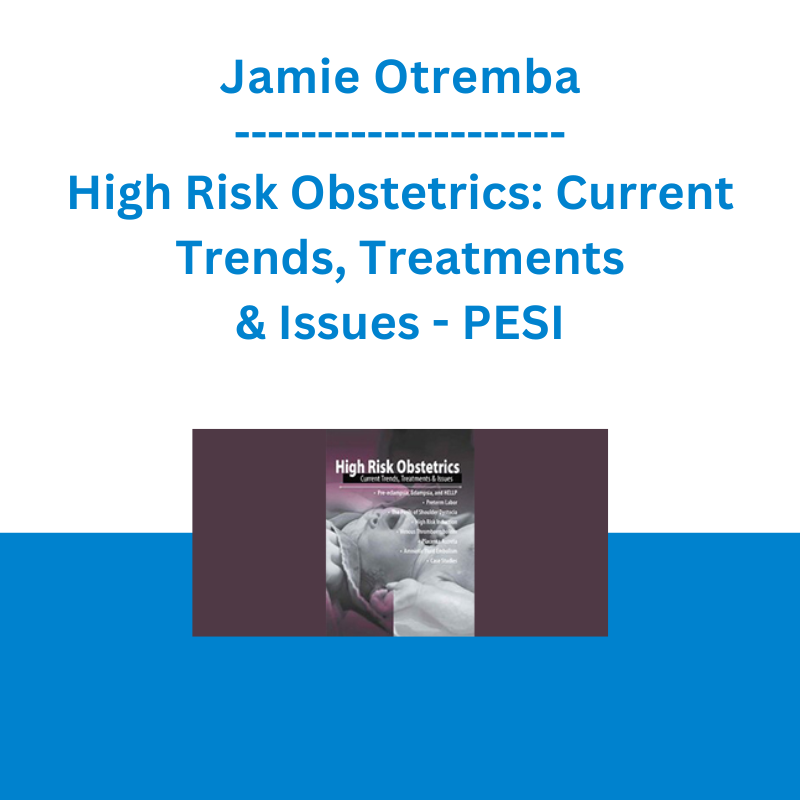*** Proof of Product ***
Exploring the Essential Features of “Jamie Otremba – High Risk Obstetrics: Current Trends, Treatments & Issues – PESI”
Speaker: Jamie Otremba, MSN, RN, CNM
Format: Audio and Video
Media Type: Digital Seminar
Description
Jamie Otremba, MSN, RN, CNM, will delve into the most common obstetrical emergencies presenting in today’s obstetrical patients. She will provide you with a comprehensive look at pre-eclampsia, eclampsia, HELLP, the pitfalls of diagnosing and treating preterm labor, shoulder dystocia, abruption, previa, postpartum hemorrhage, placenta accreta, amniotic fluid embolism, venous thromboembolism, VBACs, and inductions. Jamie’s extensive experiences in high risk obstetrics have provided her with keen insight into these often challenging and frightening situations. She is eager to share with you many of the effective interventions that she has acquired throughout her career!
Through enlightening case studies, persuasive evidence-based research, and an engaging presentation style, she will teach you the current trends, treatments and issues in high risk obstetrics. Watch this seminar to learn new strategies and techniques that can immediately impact the maternal and fetal outcomes of your obstetrical patients!
Speaker
Jamie Otremba, MSN, RN, CNM, has over 25 years of maternal child nursing experience and is currently practicing full-scope nurse-midwifery at a progressive OB/GYN clinic in suburban Minnesota. Jamie has been active in program development and benchmarking in both clinic and hospital settings. She is also one of the medical directors for the Women’s and Children’s Service Line at a large hospital and medical center in Minnesota. Jamie served as an assistant professor at Minnesota State University and has practiced in women’s health care in a variety of settings, including labor and delivery, postpartum, antenatal, and community health nursing.
She has consulted area healthcare facilities on clinical and legal practice topics, and she continues as an investigator for several medication trials pertinent to obstetric and gynecologic issues. Additionally, Jamie has enjoyed sharing her vast knowledge and experiences as a preceptor for both medical and advanced practice nursing students. Her goal is to provide you with the latest pharmacological options for pregnancy and birth to ultimately improve the maternal and fetal outcomes of your own patients.
Speaker Disclosures:
Financial: Jamie Otremba has an employment relationship with Allina Health and receives compensation as a national speaker. She receives a speaking honorarium and recording royalties from PESI, Inc. She has no relevant financial relationships with ineligible organizations.
Non-financial: Jamie Otremba is a member of the American College of Nurse-Midwives and the Network for LGBT Health Equity.
Objectives
- Evaluate the two-phase process that results in pre-eclampsia.
- Differentiate the pharmacologic management options for preterm labor.
- Determine the two most important factors in assessing risk in elective induction.
- Argue the most effective way to change medical staff practices related to high risk elective inductions.
- Determine the possible causes of a post-partum hemorrhage and appropriate management for each.
- Devise strategies for collaborative care with the ICU and Emergency Department.
- Justify why a d-dimer is no longer recommended as part of the evaluation for pulmonary embolism in pregnancy.
- Utilize the latest ACOG recommendations for preventing blood loss during the delivery with an accreta.
- Distinguish the varying degrees of abnormal placental implantation and how management might differ for each.
- Analyze why neurological outcomes with amniotic fluid embolism are so poor and the rapid interventions that could make a difference.
Outline
- Pre-eclampsia, Eclampsia and HELLP
Tips for timely intervention: Know when you MUST intervene
Maximize maternal and fetal outcomes: Latest available medical treatments & interventions
Morbidity and mortality associated with diagnosis
Case Studies - Preterm Labor: Rapid Diagnosis And Intervention Can Make all the Difference
Who is at the highest risk – and what you can do to lower it
Preterm labor or just contractions?
Beta-mimetics, Mag, Calcium channel blockers, NSAIDS, antibiotics: Who gets what? - The Perils of Shoulder Dystocia
Can we predict shoulder dystocia?
When a shoulder dystocia occurs: The essentials of management
Best first line maneuvers
Risk management considerations - Post-Partum Hemorrhage
Patients at risk for postpartum hemorrhage
New tips for assessing blood loss accurately
New medications/Old meds with new protocols
Interventions for rapid response
Algorithms for treatment
When to call the OR - High Risk Induction
Which patients are too “high risk” for induction?
Alternatives to pitocin
The newest options for inductions
Risks and benefits for induction patients
How to change your hospital policies
Examples of informed consent - Venous Thromboembolism in Pregnancy and Postpartum
#1 cause of maternal death in the US
Work up and evaluation
Anticoagulation
Treatment in pregnancy
Timing delivery - Placenta Accreta
Why is this condition on the rise?
How to identify accreta prenatally
Newest aggressive therapies to save lives
Target Audience
- Nurses
- Clinical Nurse Specialists
- Nurse Practitioners
- Nurse Midwives
- Certified Childbirth Educators/Doulas
Please see the full list of alternative group-buy courses available here: https://lunacourse.com/shop/










 Simpler Trading - Bruce Marshall - The Options Defense Course
Simpler Trading - Bruce Marshall - The Options Defense Course  George Fontanills & Tom Gentile - Optionetics 6 DVD Series Home Study Course (Digital Download)
George Fontanills & Tom Gentile - Optionetics 6 DVD Series Home Study Course (Digital Download)  Jesse Livermore Trading System - Joe Marwood
Jesse Livermore Trading System - Joe Marwood  Greg Loehr - Advanced Option Trading With Broken Wing Butterflies
Greg Loehr - Advanced Option Trading With Broken Wing Butterflies  Dave Landry - Stock Selection Course
Dave Landry - Stock Selection Course  Sovereign Man Confidential - Renunciation Video
Sovereign Man Confidential - Renunciation Video  Akil Stokes & Jason Graystone - TierOneTrading - Trading Edge 2019
Akil Stokes & Jason Graystone - TierOneTrading - Trading Edge 2019  Erik Banks - Alternative Risk Transfer
Erik Banks - Alternative Risk Transfer  Fred Haug - Virtual Wholesaling Simplified
Fred Haug - Virtual Wholesaling Simplified  The Daily Traders – Exclusive Trading Mentorship Group
The Daily Traders – Exclusive Trading Mentorship Group  Toshko Raychev - Profit System + ITF Assistant
Toshko Raychev - Profit System + ITF Assistant